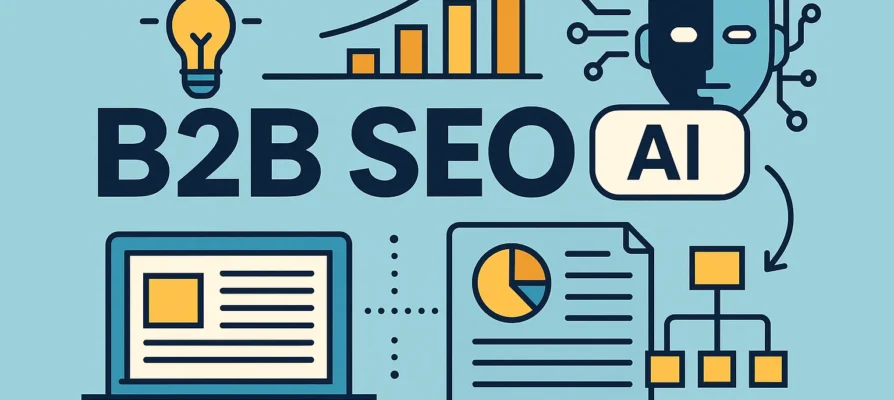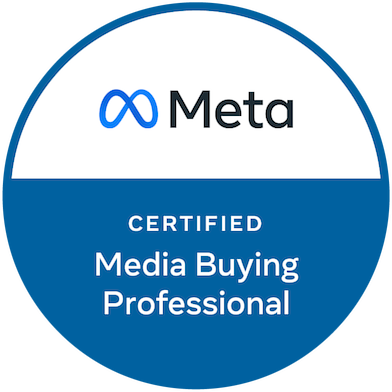B2B SEO works differently than SEO in e-commerce or editorial environments. Search volumes are smaller, target groups more specific, and customer journeys significantly more complex. Instead of optimizing for mass, B2B search engine marketing is about precision, relevance, and strategic depth.
At the same time, demands on SEO teams are increasing: content must be professionally sound, technically clean, user-centric, and performant – all under time pressure. This is exactly where the use of AI in SEO practice comes into play.
With tools like ChatGPT or other AI-powered solutions, many tasks can be completed more efficiently: from keyword clustering to analyzing search intent to semantic content expansion. But one thing is clear: AI is no replacement for SEO expertise. It’s a tool – like a drill. Without a clear strategy, it drills into nothing.
In this post, you’ll learn how to meaningfully integrate AI-powered processes into your B2B SEO strategy – not as a theoretical concept, but with concrete examples, prompts, and workflows. We’ll illustrate our tips based on the most important SEO tasks:
- Keyword intent and clustering
- Technical audit and internal linking
- Semantic content optimization
Our goal is to provide you with practical AI know-how – for measurable SEO performance in B2B marketing.
Understanding keyword intent and clustering content with AI
Traditional keyword research is often frustrating in the B2B space: too little volume, too many generic suggestions, no differentiation by target group or funnel stage. Tools like Sistrix, Ahrefs, Moz, or Google Keyword Planner remain essential – they provide valid data on search volume, competition, and trends. What they lack is context.
This is where AI SEO offers a real advantage – not in data collection, but in interpretation and structuring. AI models like ChatGPT or Claude can analyze large keyword lists by topic and search intent and translate them into meaningful clusters.
Analyzing and clustering search intent
A concrete example: You run an HR-focused SaaS company. Your research gave you a list of 50 keywords – from “digital time tracking for SMEs” to “HR analytics tools comparison.” Instead of manually sorting them, let an AI model do the following:
Example prompt:
“Group the following keywords by search intent (informational, transactional, commercial investigation, navigational) and suggest a suitable content type for each (e.g., blog post, landing page, comparison page, glossary).”
The result is a structured, editorially usable cluster that can be directly translated into a B2B SEO strategy.
Developing topic clusters and pillar pages
Based on these clusters, you can structure topic worlds or content hubs – with a central pillar page and several subpages. Example:
- Pillar: Digital time tracking for SMEs
- Subpages: “Time tracking via app,” “Legally compliant time tracking in Switzerland,” “Mobile time tracking for field teams,” “Time tracking for remote teams”
AI can not only identify such structures but also check for completeness, offering a clear advantage for scalable B2B SEO concepts.
Generating user questions – preparing snippets and FAQ sections
AI solutions also shine in generating user questions for a given keyword. These questions are ideal for FAQ sections or featured snippets.
Example prompt:
“What questions might someone ask who is searching for ‘digital time tracking SME’?”
The model instantly returns relevant questions such as:
- “Is time tracking with Excel still allowed?”
- “Which providers exist for SMEs in Switzerland?”
- “How does mobile time tracking work on construction sites?”
These are not only SEO-relevant but also highly user-oriented – a key foundation for modern SEO texts supported by AI.
Automating SEO audits: meta tags, structure, internal linking
Technical SEO audits are essential – but time-consuming. Especially with large websites, checking meta tags, internal linking, and content structure quickly becomes a bottleneck. This is where AI SEO can be efficiently scaled – provided you use the right tools and connect them meaningfully.
Automatically checking on-page structure with AI integration
Imagine crawling your site with Screaming Frog and exporting the data for manual analysis in Excel or Google Sheets. With the OpenAI API, this process can be automated.
Concrete workflow:
- Crawl website with Screaming Frog
- Export relevant data (e.g., meta titles, H1s, word count, status codes)
- Pass data to GPT model via API or script
- Automatic evaluation: missing titles, duplicate headers, short content, non-indexed pages
This saves hours of manual work and enables focused action within your B2B SEO strategy.
Generating meta descriptions with GPT
Missing or unattractive meta descriptions are a common audit finding. With Screaming Frog’s AI integration, these can not only be identified but also automatically replaced.
Example prompt for API integration:
“Write a meta description (max. 155 characters) for the following text. Include the main keyword and a clear benefit or CTA.”
The result is immediately usable suggestions – perfect for large projects with dozens of pages. But: the quality varies. Use the suggestions as a starting point, not the final version, because AI SEO text is fast, but not flawless.
Building internal linking logically with AI and semantic mapping
Internal linking is a highly underrated SEO lever. Many websites link based on gut feeling or just navigation. With Screaming Frog integration, semantic maps can now be created, where AI detects topic relationships, content gaps, and missed linking opportunities.
Example use cases:
- Automatically detect and link topically related pages
- Suggest consistent, intent-based anchor texts
- Eliminate duplicate links and dead ends
The result of this B2B SEO measure is a logically structured, content-coherent setup that benefits both users and crawlers.
Content optimization for search intent and semantic relevance
Good B2B content isn’t just “SEO-compliant” – it answers precise questions, solves real problems, and meets specific information needs. Tools like ChatGPT, SurferSEO, or Frase help evaluate and expand existing content in a targeted way.
Compared to generic text generators, the strength of AI SEO text here is not in pure writing, but in intelligent structuring and extension based on real search intent.
AI-powered SERP analysis to define content type and depth
Which content currently works for a given keyword? AI can analyze exactly that – and derive actionable recommendations.
Example prompt:
“Analyze the top 10 Google results for the keyword ‘HR software comparison.’ What content formats dominate? What structure is common? What questions are answered?”
The GPT model can identify if comparison tables, vendor lists, or decision guides are expected. This insight is gold for AI-supported SEO texts in B2B.
Semantic expansion of existing content
Tools like SurferSEO or Frase help identify relevant terms and concepts missing from your content. Combined with GPT, you can generate targeted new paragraphs:
- Additional information for depth
- Glossary entries for technical terms
- CTAs guiding to the next funnel step
- Q&A sections for snippets or knowledge panels
Example prompt:
“Expand this section with an additional perspective on ‘time tracking obligations in Switzerland.’ Goal: provide context, build trust, mention legal foundations.”
The benefit: you retain editorial control while saving time on thematic research. The result is a refined, high-performing AI SEO text that aligns search intent with user needs.
Detecting duplicate content and content gaps
Also valuable is AI-supported analysis of your existing content. Combined with Screaming Frog or a CMS export, AI can detect near-duplicate landing pages on the same topic – semantically redundant and counterproductive for SEO.
Example:
Two pages cover “digital time tracking” – one for construction companies, one for agencies. GPT detects that the content is 80% identical. Recommendation:
- Merge into one core article with audience-specific sections
- Or: clearly differentiate through use cases, screenshots, arguments
At the same time, AI identifies that a topic like “mobile time tracking in the field” is currently missing – an ideal entry point for new, strategically valuable content.
Especially in B2B SEO, where content often scales across products or industries, this function is extremely valuable.
Limits and responsibility: where AI reaches its boundaries
As powerful as AI is today – it has its weaknesses. Using AI for SEO without a plan risks duplicate content, misinformation, and low content quality that convinces neither readers nor Google.
Fact:
A good prompt is not a strategy. A generated text is not a finished article. And a tool like ChatGPT can detect connections – but not verify if a statement is factually correct, legally sound, or on-brand.
Where AI helps – and where it doesn’t:
| Strong in … | Limitations in … |
| Keyword clustering | Prioritizing by business value |
| Content expansion | Brand tone and emotional appeal |
| SERP analysis (top 10 results) | Competitive strategy and differentiation |
| Meta tags and headlines | Creative concepts and campaign ideas |
| Internal linking by topic logic | Targeted funnel steering |
Another point: AI knows no company goals, no personas, no USPs – unless you explicitly tell it. That means: the stronger your input, the better the output. Anyone who simply “lets content be generated” gets average, generic results.
What does this mean for your B2B SEO?
AI is a tool, not a strategist, editor, or quality control.
You can automate processes, derive ideas, and structure content. But: content responsibility remains with you – or your agency. Especially in B2B SEO, where complex topics, long sales cycles, and high-explanation products are common, this is non-negotiable.
Recommendation:
Use AI as a co-pilot. Give it clear tasks, clear goals, and clear boundaries. Then it will deliver reliably. Everything else is just playing around.
Next step: Integrate AI meaningfully into your SEO
Want to make your B2B SEO processes more efficient without compromising on content quality or strategic depth?
Then talk to us about your specific case. We’ll show you how to integrate AI-supported workflows into your existing system – structured, scalable, and focused on performance and conversions.
Get in touch now – for an initial conversation that delivers more than just buzzwords.









